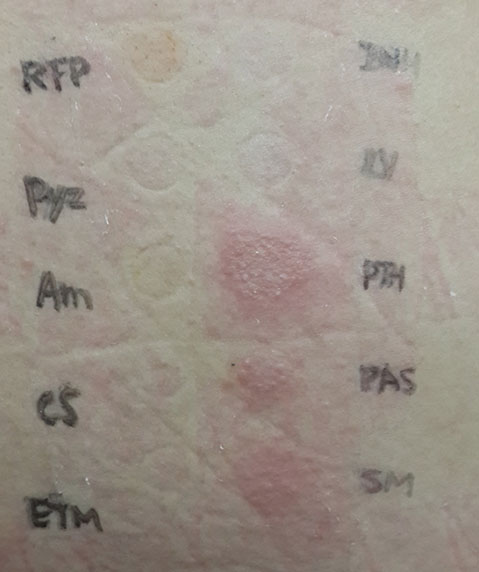Allergy Asthma Respir Dis.
2015 Jul;3(4):297-301. 10.4168/aard.2015.3.4.297.
Successful readministration of second-line antituberculous agents in a patient with near-fatal drug reaction with eosinophilia and systemic symptoms (DRESS) syndrome
- Affiliations
-
- 1Department of Internal Medicine, Seoul National University College of Medicine, Seoul, Korea. helenmed@snu.ac.kr
- 2Institute of Allergy and Clinical Immunology, Seoul National University Medical Research Center, Seoul National University College of Medicine, Seoul, Korea.
- 3Regional Pharmacovigilance Center, Seoul National University Hospital, Seoul, Korea.
- 4Department of Internal Medicine, Kyungpook National University School of Medicine, Daegu, Korea.
- KMID: 2218661
- DOI: http://doi.org/10.4168/aard.2015.3.4.297
Abstract
- For the treatment of multidrug-resistant (MDR) tuberculosis, maintenance of appropriate antituberculous agents is essential because of its low cure rate and high dropout rate. Drug reaction with eosinophilia and systemic symptoms (DRESS) syndrome is a severe drug-induced systemic hypersensitivity response resulting in cessation of causative agents. In cases of second-line antituberculous agent-induced DRESS, it is extremely difficult to find other replacement medications to cure MDR tuberculosis. A 53-year-old male who had taken the second-line antituberculous agents (cycloserine, streptomycin, p-aminosalicylic acid, and prothionamide) as well as pyrazinamide for 5 weeks experienced DRESS syndrome accompanying hepatic coma. His symptoms improved with discontinuation of antituberculous agents and administration of high-dose methylprednisolone for 1 month. To resume the antituberculous medication, second-line antituberculous agents were administered one by one using a rapid desensitization protocol. While kanamycin, levofloxacin, and cycloserine were successfully readministered, p-aminosalicylic acid- and prothionamide-induced cutaneous hypersensitivity symptoms were relatively mild compared to previous reactions. Herein, we report a case of successfully treated MDR tuberculosis having a history of fatal DRESS syndrome to antituberculous agents using the rapid desensitization protocol.
MeSH Terms
-
Aminosalicylic Acid
Antitubercular Agents
Cycloserine
Desensitization, Immunologic
Drug Hypersensitivity Syndrome*
Hepatic Encephalopathy
Humans
Hypersensitivity
Kanamycin
Levofloxacin
Male
Methylprednisolone
Middle Aged
Patient Dropouts
Pyrazinamide
Streptomycin
Tuberculosis
Tuberculosis, Multidrug-Resistant
Aminosalicylic Acid
Antitubercular Agents
Cycloserine
Kanamycin
Methylprednisolone
Pyrazinamide
Streptomycin
Figure
Cited by 1 articles
-
DRESS (drug reaction with eosinophilia and systemic symptom) syndrome caused by both first-line and second-line antitubercular medications: A case report with a brief literature review
Young-Hoon Hwang, Dong Yeon Jang, Sung Yoon Kang, Kyung-Hee Sohn, Dong Yoon Kang, Chang Hoon Lee, Hye-Ryun Kang
Allergy Asthma Respir Dis. 2017;5(2):111-116. doi: 10.4168/aard.2017.5.2.111.
Reference
-
1. World Health Organization. Global tuberculosis report 2013 [Internet]. Geneva: World Health Organization;2013. cited 2014 Apr 1. www.who.int/iris/bitstream/10665/91355/1/9789241564656_eng.pdf.2. Kim HJ. Current status of tuberculosis in Korea. Korean J Med. 2012; 82:257–262.
Article3. Kim DH, Kim HJ, Park SK, Kong SJ, Kim YS, Kim TH, et al. Treatment outcomes and long-term survival in patients with extensively drug-resistant tuberculosis. Am J Respir Crit Care Med. 2008; 178:1075–1082.
Article4. Walsh SA, Creamer D. Drug reaction with eosinophilia and systemic symptoms (DRESS): a clinical update and review of current thinking. Clin Exp Dermatol. 2011; 36:6–11.
Article5. Cacoub P, Musette P, Descamps V, Meyer O, Speirs C, Finzi L, et al. The DRESS syndrome: a literature review. Am J Med. 2011; 124:588–597.
Article6. Galvao VR, Aun MV, Kalil J, Castells M, Giavina-Bianchi P. Clinical and laboratory improvement after intravenous immunoglobulin in drug reaction with eosinophilia and systemic symptoms. J Allergy Clin Immunol Pract. 2014; 2:107–110.
Article7. Joly P, Janela B, Tetart F, Rogez S, Picard D, D'Incan M, et al. Poor benefit/risk balance of intravenous immunoglobulins in DRESS. Arch Dermatol. 2012; 148:543–544.
Article8. Santhamoorthy P, Alexander KJ, Alshubaili A. Intravenous immunoglobulin in the treatment of drug rash eosinophilia and systemic symptoms caused by phenytoin. Ann Indian Acad Neurol. 2012; 15:320–322.
Article9. Chiriac AM, Demoly P. Multiple drug hypersensitivity syndrome. Curr Opin Allergy Clin Immunol. 2013; 13:323–329.
Article10. Scherer K, Brockow K, Aberer W, Gooi JH, Demoly P, Romano A, et al. Desensitization in delayed drug hypersensitivity reactions: an EAACI position paper of the Drug Allergy Interest Group. Allergy. 2013; 68:844–852.
Article11. Holland CL, Malasky C, Ogunkoya A, Bielory L. Rapid oral desensitization to isoniazid and rifampin. Chest. 1990; 98:1518–1519.
Article12. Matz J, Borish LC, Routes JM, Rosenwasser LJ. Oral desensitization to rifampin and ethambutol in mycobacterial disease. Am J Respir Crit Care Med. 1994; 149(3 Pt 1):815–817.
Article
- Full Text Links
- Actions
-
Cited
- CITED
-
- Close
- Share
- Similar articles
-
- Drug Reaction with Eosinophilia and Systemic Symptom Syndrome Due to Everolimus: A Case Report
- Rasagiline Induced Drug Rash with Eosinophilia and Systemic Symptoms Syndrome: A Case Report
- Eosinophilic Polymyositis and DRESS (Drug Rash with Eosinophilia and Systemic Symptoms) Syndrome by Antitubercular Agents
- Diagnosis and Management of DRESS (Drug Reaction with Eosinophilia and Systemic Symptoms) Syndrome
- DRESS (drug reaction with eosinophilia and systemic symptom) syndrome caused by both first-line and second-line antitubercular medications: A case report with a brief literature review


